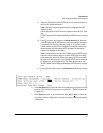
Time Protocols
SNTP: Viewing, Selecting, and Configuring
Even though, in this example, TimeP is the
current time synchronous method, the
switch maintains the SNTP configuration.
Figure 9-3. Example of SNTP Configuration When SNTP Is Not the Selected Time Synchronization Method
Configuring (Enabling or Disabling) the SNTP Mode
Enabling the SNTP mode means to configure it for either broadcast or unicast
mode. Remember that to run SNTP as the switch’s time synchronization
protocol, you must also select SNTP as the time synchronization method by
using the CLI
timesync command (or the Menu interface Time Sync Method
parameter).
Syntax: timesync sntp
Selects SNTP as the time protocol.
sntp < broadcast | unicast >
Enables the SNTP mode (below and page 9-10).
sntp server < ip-addr >
Required only for unicast mode (
page 9-10).
sntp poll-interval < 30 . . 720>
Enabling the SNTP mode also enables the SNTP poll interval
(default: 720 seconds; page 9-12).
Enabling SNTP in Broadcast Mode. Because the switch provides an SNTP
polling interval (default: 720 seconds), you need only these two commands
for minimal SNTP broadcast configuration:
Syntax: timesync sntp
Selects SNTP as the time synchronization method.
sntp broadcast
Configures
Broadcast as the SNTP mode.
For example, suppose:
■ Time synchronization is in the factory-default configuration (TimeP
is the currently selected time synchronization method).
■ You want to:
1. View the current time synchronization.
9-9


















